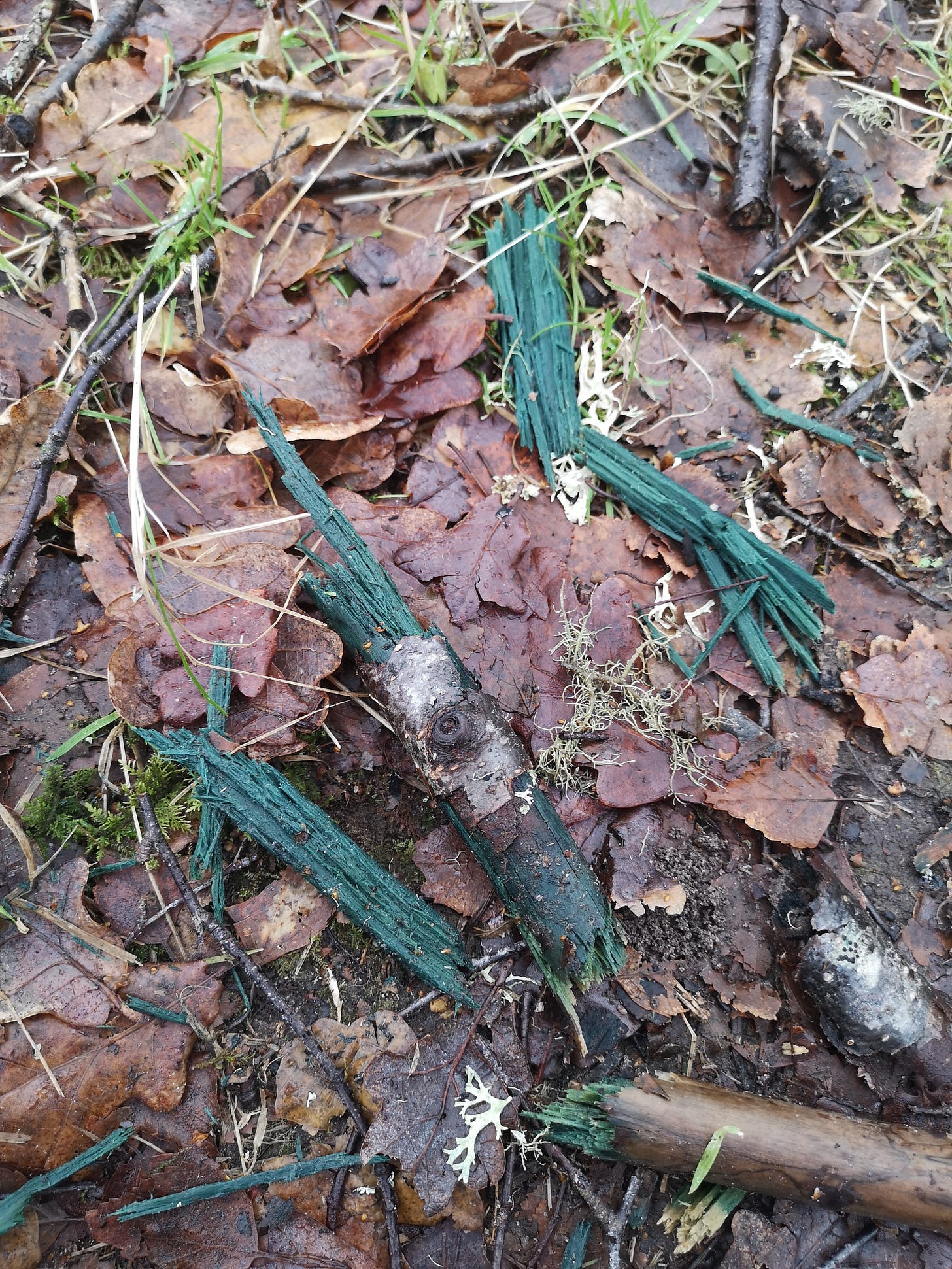Have you ever strolled through a woodland, stumbled upon an enchanting shade of green wood, and marveled at its unique hue? Congratulations, you've encountered Chlorociboria aeruginosa, commonly known as the green elf cup fungus. The scientific moniker 'aeruginosa' derives from the Latin word for copper oxidation or verdigris, perfectly capturing the fungus’ striking colour.
In contrast to most fungi that pointedly reveal themselves only when a mushroom emerges, the impact of this particular species is visible year-round, bringing a burst of much-needed colour to even the greyest winter day.
While the green elf cup fungus is common and widely distributed across the UK and Europe, its elusive fruiting bodies are a rare spectacle. I count myself fortunate to have chanced upon them just once at Rogie Falls, marking my sole encounter with these enchanting 'cups' throughout my entire career. For me, this discovery holds the same significance as spotting my first crested tit or witnessing the fin whale in the Beauly Firth.
The mycelium of this fungus, as it acts on the wood, bestows upon it a vivid and captivating green hue. Woodworkers have prized this transformation since as early as the 14th century in Europe.
Imagining our elven friends cherishing this unique wood as a building material for their homes adds, for me, a touch of whimsy. Alas, the fungus is saprobic, feeding on dead and decaying wood, making it less likely to serve as a structurally sound building material. Perhaps they use the fruiting cups instead for their autumnal parties?
But could there be a more modern use in it’s future? Some recent research has identified that the pigment produced by the fungi, xylindein, could be used as a semiconductor on large wearable substrates like wearable electronics.
Nevertheless, its undeniable beauty often tempts me to bring a piece home as a keepsake—a reminder of the daily wonders that surround us, showcasing nature's beauty even on the gloomiest of days. As we stand in awe of nature's artistry through this green-hued wood, let us remember our own role in its preservation. Each action towards conservation ensures that such wonders continue to inspire and enrich our lives. Let's cherish and protect these natural marvels for future generations to marvel at.
Marcia O'Hara is High Life Highland's dedicated Countryside Ranger for Easter Ross and South East Sutherland. She infuses her love for nature into every aspect of her work, from community clean-ups to guided events and workshops. With an academic foundation in Environmental Biology, Marcia excels in bringing fresh perspectives to her sessions, making science come alive in community learning. Known for her ability to engage and inspire, Marcia has a special interest in woodland botanics, including fungi, lichen, and trees. Her unique approach and deep connection to nature have made her an invaluable asset in preserving the natural beauty of the region she covers.
WINTER TREE I.D. WORKSHOP
22nd February from 14:00 - 16:00
In person at the beautiful Big Burn in Golspie
Amazing value! IT’S FREE!!!! Winter Tree ID workshop event taking place soon with Marcia O’Hara. In the Winter Tree Identification Workshop at the Big Burn in Golspie, you will learn a variety of skills that are both educational and enjoyable, especially for those interested in botany, ecology, and the natural environment. Here are some key themes for discussion on the day:
Tree Identification Techniques: Learn how to identify different tree species during winter when they are without leaves. This includes studying the distinct characteristics of trees such as bark textures and patterns, bud shapes and sizes, branch structures, and tree silhouettes.
Understanding Tree Ecology: Gain insights into the ecological roles that different trees play in the Highland ecosystem. This includes understanding how trees interact with other plant and animal species, and their importance in maintaining ecological balance.
Adaptations to Winter Conditions: Discover how trees survive the harsh winter conditions, including their physiological and structural adaptations. Dormancy, frost resistance, and energy conservation strategies of trees during winter.
Practical Fieldwork Experience: Apply your learning in a real-world setting through the guided walk in the Big Burn area. This hands-on experience will be crucial for solidifying your identification skills and understanding the practical aspects of tree ecology.
Conservation Awareness: Understand the challenges faced by trees and forests in modern times, including environmental threats and conservation efforts.
Marcia’s workshop is designed to be engaging and informative, catering to both beginners and those with some prior knowledge of botany or ecology. By the end of the session, participants will have a deeper appreciation of the natural world in winter and be equipped with skills to identify and understand trees in winter in their natural habitat.
We ask for donations for this event to help with our work, which goes towards education about and protection of the nature of the Highlands. Please give what you feel you can afford. We suggest a minimum donation of £5 per person to cover our costs or £10 per person to further support our work.
* Please be aware that there is a minimum donation of £1 required to book on via Eventbrite. This does not go to the Ranger Service but is to cover Eventbrite Fees.*







